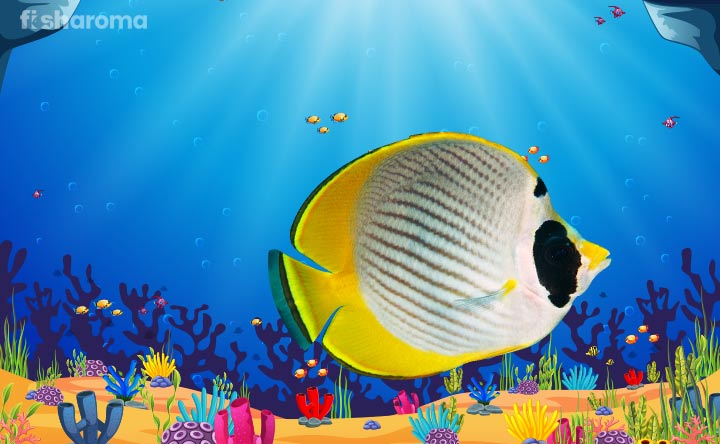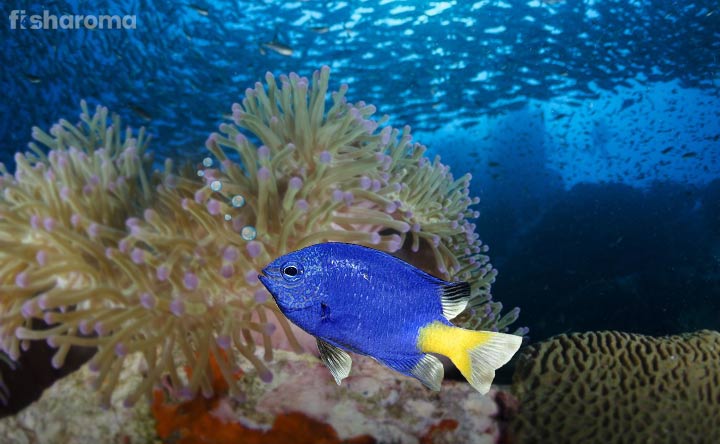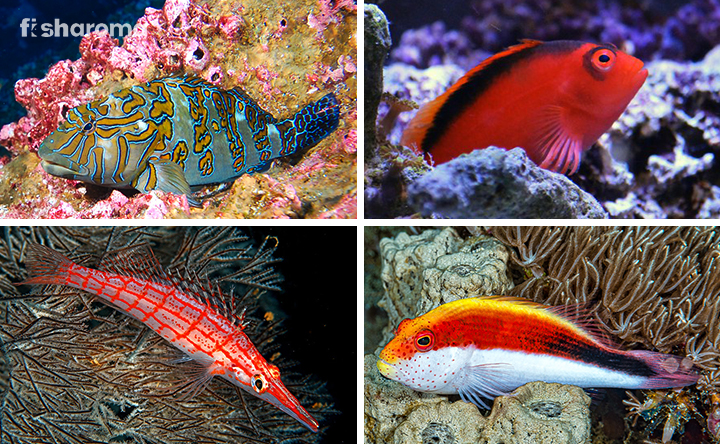Royal Gramma – The Complete Care Guide for Your Royal Pet Fish

- Origin of Royal Gramma
- Royal Gramma’s Appearance
- Tank Necessities for Royal Gramma
- Water Type for Royal Gramma
- Royal Gramma’s Temperament
- Suitable Tank Companions for Royal Gramma
- Royal Gramma’s Feeding Requirements
- Breeding of Royal Gramma
- Diseases of Royal Gramma with Preventive Measures
- Types of Basslet Fish
Do you love making colorful and elegant fish your eye-candy by keeping them in your aquarium? If yes then try to select calm-tempered Royal Gramma for your fish tank because of its easy-breeding process. Royal Gramma can be the best companion for both beginners and experienced fish-keepers because of its peaceful characteristic and small size. This Saltwater fish breed is often kept in a marine aquarium in residential and commercial places.
Quick Details on Royal Gramma
Let’s have a look at quick information on the marine water-dwelling fish Royal Gramma by this table:
| Scientific Name | Gramma loreto |
| Origin | Tropical Western Atlantic Ocean |
| Life-Span | 3-5 Years |
| Color | Yellow, Purple, Violet |
| Temperament | Peaceful |
| Size | Up to 3” (7 cm) |
| Diet | Carnivore |
| Family | Grammidae |
| Compatibility | Friendly |
| Tank Size | 30 Gallons |
| Care Level | Easy |
Overview
Native to the Caribbean Sea, this marine water fish is also known as Fairy Basslet and Gramma Loreto is easy to manage and aesthetically colored with the purple and yellow-shaded bicolor body. This breed belongs to the Basslet and Grammidae family. Royal Gramma is reef compatible and because of its passive nature, it is familiar with other aquatic species in the fish tank. Beginners prefer to keep this fish in the aquarium because it’s hardy with a strong immune system. You can purchase this fish at $10-$30, although the price may differ from place-to-place.
Try to make the ambiance of the aquarium like the environment of the marine ecosystem and avoid fitting harsh light on the ceiling of the tank because Gramma does not prefer such lighting in the living place of Royal Gramma.
Origin of Royal Gramma
This colorful tropical fish travels from Florida to the Northern coast of South America and is found in the Caribbean Western Atlantic Ocean. This saltwater fish is not territorial but prefers to dwell in peaceful places that are surrounded by coral reefs, sea plants, and small rocks. So, you should keep your colorful companion happy by providing it with the same ambiance and amenities as the coastal marine water.
Royal Gramma’s Appearance
Royal Gramma’s vibrant and beautiful looks can be the crowning glory to your fish tank. The front half portion of this fish is blended with a purple hue and the tail is covered with golden-yellow shade. Moreover, a series of cute dots in the body of Gramma portrays its royal appearance.
You will also find a thin black line extending from the mouth of the fish through its eyes and dorsal fin. The size of the fish is 3” (7 cm), and if you want to identify its sex then observe them minutely. You will find the males are larger in size than the females and their ventral fins are also quite bigger than the female Gramma. Also, the male fish are brighter and more vibrant than the females.
The Royal Gramma is often confused with another fish Royal Dottyback because both of them look quite similar, but Dottyback is aggressive and low compatible fish with other species. If you want to know the difference then you will see, there is no color blending in the body of the Royal Dottyback, whereas Royal Gramma has purple fades in the yellow portion
Tank Necessities for Royal Gramma
You need to create a coastal environment if you are planning to breed Royal Gramma. The natural living place of this fish is surrounded by vast rocks like coral outcropping, reefs, and small caves. So, to make your cute little friends happy and healthy, make the environment of the fish tank same like the marine water system.
Tank Size
The minimum tank size for them should be 30-50 gallon. If you are keeping a group of Grammas and other fish then the size should be 100+ gallons.
Ornaments
Add coral rocks, reefs, sea plants, hiding caves and dim light in the fish tank because Grammas are shy fish and they like hiding inside the caves for their comfort and peace.
Filter
Keep a power filter in the fish tank of Royal Gramma, so that the water pollutants easily get filtered out with the help of the aquarium filter. Moreover, this filter has the capacity to bring high flow in the aerated water of the aquarium.
Lighting
This fish of Basslet family lives deep in the water covered by herbs and bushes, so it does not like dwelling under a harsh light. Try to install normal lighting on the ceiling of the tank.
Water Type for Royal Gramma
Managing proper hardness and temperature of the water is necessary, so follow a few instructions to maintain the health of your pet Royal Gramma.
Temperature
The water temperature should be from 72-78°F (22-25 °C).
pH Level
The pH level of the water should be 8.1-8.4
Hardness
The carbonate hardness of the water should be 8-12 dKH.
Specific Gravity
The specific gravity of the water should be 1.020-1.025.
Floral Choice
Try to maintain the natural environment while you are setting plants in the fish tank because Royal Gramma prefers eco-friendly environment.
Cleaning Procedure
You can use a gravel vacuum to clean the small rocks and gravels in the aquarium. Moreover, use aerated water, liquid soap, and a soft brush to wash out the dirt and algae from the corners and objects of the tank. After the wash, wipe out the body of the tank from a dry soft cloth.
Replacement Process
No need to change the entire water from the tank during the replacement process. Change about 10% of water if you do the replacement in a week and change about 20-25% of water if you are replacing the water once in a month. Carefully shift the fish from one tank to another during
Royal Gramma’s Temperament
Being a passive-natured shy and peace-loving tempered species, this fish is easily compatible with other fish that are non-aggressive and calm. But they turn territorial when other fish intrude them or disturb them. Moreover, they are fearful in nature and often get scared when any water species chase Gramma, so avoid keeping aggressive predators and less familiar fish with Gramma. Try to look to its comfort, otherwise, Royal Gramma may get affected with anxiety which can result in different illnesses and color fading. Thus, keep your cute buddy happy by providing it a safe home and joyful livelihood.
Suitable Tank Companions for Royal Gramma
This marine water fish is very calm and avoids fighting, so it prefers living with other fish which never harms. Royal Gramma prefers similar-looking colorful fish as its tankmates. Also, there is no problem if you keep a group of male or female Royal Grammas together in a fish tank. The male and female Gramma pairs prefer living together. Have a look at the names of some familiar fish and other species that can be the best tankmates for Royal Gramma:
- Squirrelfish
- Angel Fish
- Boxfish
- Filefish
- Clownfish
- Jawfish
- Gobies
- Rabbitfish
- Hawk Fish
- Invertebrates
- Corals
Unsuitable Tankmates
Royal Grammas get aggressive and start chasing other fish only when they are disturbed and poked by other notorious water species. Moreover, when they become rageful, they open their jaws as wide as possible like Great White Shark to gulp and attack their enemies. So, try to make lots of rockwork and caves in the aquarium for the privacy and safety of Gramma. Never get confused with the aggressive Royal Dottyback which looks like Royal Gramma which can attack Grammas because of the similar appearance and rageful nature. Also, avoid keeping other aggressive, larger, and predator fish in the fish tank that can injure or eat Royal Gramma such as:
- Eels
- Line Wrasse
- Red Scooter Blenny
- Lionfish
- Sharks
- Snappers
Royal Gramma’s Feeding Requirements
This natural habitat of the coastal area is planktivorous because it consumes phytoplankton and zooplankton. It is also a cleaner fish that eats the parasites from the skin of other fish in the water. It is also carnivorous and you may feed them the following things:
- Mysis Shrimp
- Brine
- Crustaceans
- Dead Fish
- Oysters
- Squid
You may also buy frozen and dry foods for your swimmer buddy as follows:
- Hikari Mega-Marine Angel
- Ocean Nutrition Prime Reef Flakes
- Hikari Marine Seaweed Extreme
Always feed this fish 2-3 times every day because giving proper food and maintaining the time schedule will help your fish stay healthy and grow faster without any ailments.
Breeding of Royal Gramma
Before the breeding process, the male Royal Gramma starts building the nest using algae and rocks where the female gives 5-40 eggs. The male releases his sperm to fertilize the eggs and this usually occurs during the early summer or spring season.
The breeding process of Royal Gramma is very easy; you just need to keep coral reefs and hiding caves for the reproduction process. After the fertilization of the eggs, feed the mothers rotifers and copepods. When they develop properly, try feeding them newly hatched shrimp.
Diseases of Royal Gramma with Preventive Measures
Compared to other fish, Royal Gramma is quite strong and high-resisting fish that are less affected by different diseases. However, Gramma consumes parasites, so it is affected by infections such as:
- Ich
- Fungal Infection
- Bacterial Infection
You don’t need to give much effort for the prevention and intervention to the health of this calm-natured fish. Just keep the reefs, rocks, and caves of the water clean, and change the tank water thrice a week to maintain the hygiene of Gramma’s living place. Also, manage the diet plan in the correct way as mentioned above because timely food will help your tiny friend live for a long time without any health issues.
Types of Basslet Fish
There are multiple seawater small fish that belong from Basslet family other than Royal Gramma. Take a look at different types of Basslet fish:
- Black Cap Basslet – You will find this fish just like Royal Gramma in the deepwater of the Caribbean Sea. The body of this fish is light purple and the jet-back diagonal cap is on the topmost part of the fish. This fish is carnivorous and prefers consuming shrimps and invertebrates. The 4” (10 cm) fish can be a nice addition to your reef aquarium because of its small size and colorfulness.
- Chalk Basslet – Chalk Basslet is also an inhabitant of the Caribbean Sea and its multicolored body really looks beautiful if you keep it in your fish tank. This is a tiny fish that grows up to 3.1” (9 cm) in length and is shaded with a purple and bright blue body. The backside of its body is banded with orange shade. You will generally find this fish in the underwater caves of deep water, so the ambiance of your aquarium should also be like that.
- Bicolor Basslet – You will find this fish in the Indo-Pacific Ocean. The front-half portion of the fish is bright pink and the rear half is yellowish; therefore, this fish has earned the name, Bicolor Basslet Fish.
- Tobacco Basslet – The other names of this fish are Sand Fish and Golden Fish found in the shallow parts in the coral areas of the Tropical Western Atlantic Ocean.
- Gold Assessor Basslet – The golden-colored Gold Assessor Basslet is outlined with red fins. Generally, this fish grows up to 3” in length. Aquarists collect them from Fiji to keep the fish in their aquarium.
- Harlequin Basslet – You can find this fish near the Caribbean Sea, but you have to choose large aquariums because of the jumping nature of this 4” fish.
- Swiss Guard Basslet – Swiss Guard Basslet is found in the Tropical Western Atlantic Ocean and the Caribbean Sea. The mustard-yellow, red and black striped body of this fish is a rare combination. The outline of the fish is black and this fish grows up to 3” (7 cm).
- Strawberry Basslet – Usually this bright purple-colored fish originated from the Pacific Ocean and its maximum length is 2.4” (6.5 cm).
Care Guide for Royal Gramma
When you are planning to breed this peaceful species, remember just look after its comfort, health needs and feeding requirements as mentioned above. At least 30 gallons space should always be given to Royal Gramma while keeping it in a fish tank. Try to keep 115 liters of medium temperature water and keep dim light in the tank, so that the fish do not feel uncomfortable in the tank because of harsh light and warm temperature. Remember, the living conditions and foods are always the necessary things to be managed while breeding small saltwater fish like Royal Gramma.
Caring your cute little buddy means looking after the comfort and necessities of the breed. If you can look after the requirements properly by following the aforesaid suggestions then it will increase the longevity of Royal Gramma and keep it stress-free. It is your first responsibility to consult with veterinary doctors or expert aquarists if you are planning to adopt a pet fish like Royal Gramma as your companion.
Interesting Facts of Royal Gramma
- Royal Gramma and other Basslet fish breed at dusk to safeguard their eggs from predator aquatic species.
- These fish can change their sex from female to male.
- Line Wrasse Fish is always curious about the nest of Royal Gramma.
Know about More Saltwater Fish for Keeping them in Your Aquarium
Along with Royal Gramma, there are numerous saltwater fish that can be collected for your aquarium, and a few of them are:
- Moray Eel: This classic fish is also a marine ecosystem living water species that can be kept in your aquarium, but it is semi-aggressive and its care level is moderate because of its rageful nature.
- Pipefish: Pipefish can be both aggressive and peaceful depending on the conditions of the species. This 8” fish belongs to the family of a sea horse and looks like a long pipe of different colors.
- Butterflyfish: Butterflyfish is an exotic colored fish, peaceful but moderate to care. Fish-keepers love to breed this fish in their fish tank because of its beautiful looks and flamboyant colors.









